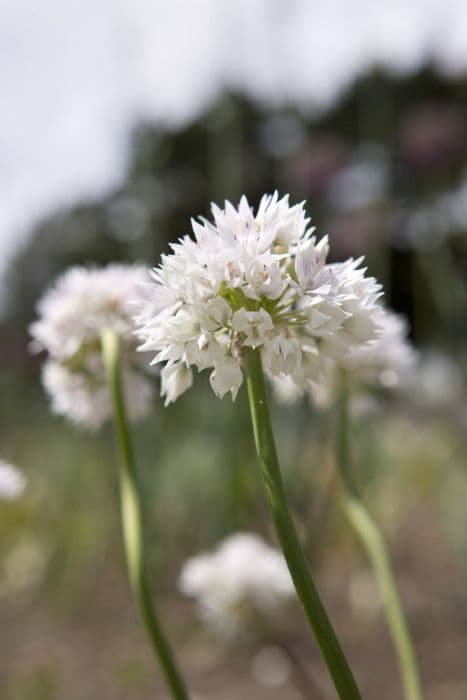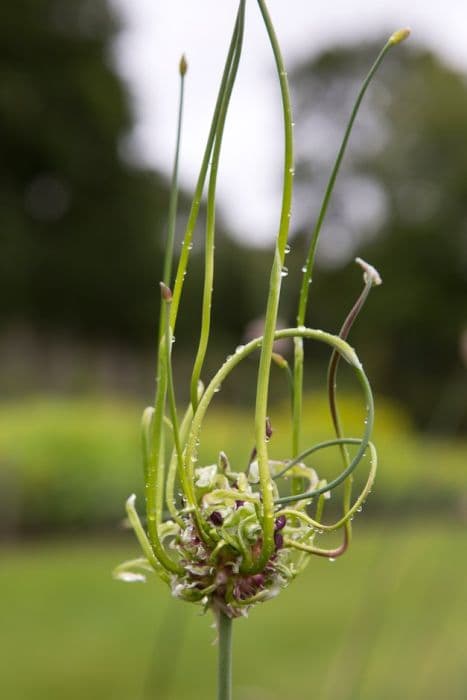Pink Lily Leek Allium oreophilum 'Zwanenburg'

ABOUT
Allium oreophilum 'Zwanenburg', widely known as the pink lily leek, showcases a charming floral display with vibrant colors. The plant bears attractive, star-shaped flowers with an intense pink hue, exuding a lively and inviting appeal. These flowers are neatly clustered atop sturdy, slender stalks, creating an umbrella-like inflorescence that gives the impression of a delicate floral canopy. The blooms are tightly packed, often resembling a pom-pom, and they can add a touch of whimsy to any garden setting. The foliage of the pink lily leek is typically long, narrow, and grass-like, presenting a lush green that contrasts beautifully against the vivid pink of the flowers. The leaves tend to arch, adding a graceful texture to the overall appearance of the plant. This elegant foliage often serves as an appealing backdrop for the prominent flowers. Although the dimensions of the plant are not the focus, the pink lily leek's visual impact in a garden is not reliant on its size but on its striking color and form. It's a captivating plant that can turn heads and induce admiration without overwhelming with stature. Overall, the pink lily leek, with its combination of graceful leaves and stunning flower clusters, presents a spectacular sight when in full bloom. It is a gem among garden plants, providing a burst of color and a touch of elegance to any planting scheme.
About this plant
 Names
NamesFamily
Amaryllidaceae
Synonyms
Pink Lily Leek, Ornamental Onion
Common names
Allium oreophilum 'Zwanenburg'.
 Toxicity
ToxicityTo humans
Allium oreophilum 'Zwanenburg', commonly known as Pink Lily Leek, is generally not considered toxic to humans. As with other members of the Allium family, such as onions and garlic, it may cause gastrointestinal discomfort if consumed in large quantities. However, typical exposure or dietary intake is unlikely to cause serious harm to a healthy adult.
To pets
Pink Lily Leek can be toxic to pets, especially cats and dogs. It belongs to the Allium species, which contain compounds that can cause oxidative damage to red blood cells, potentially leading to hemolytic anemia in animals if ingested in significant amounts. Symptoms of poisoning may include vomiting, diarrhea, abdominal pain, appetite loss, lethargy, weakness, and in severe cases, difficulty breathing or collapse. It is important to avoid feeding pets any part of this plant and to seek veterinary care immediately if ingestion is suspected.
 Characteristics
CharacteristicsLife cycle
Perennials
Foliage type
Deciduous
Color of leaves
Green
Flower color
Pink
Height
6 inches (15 cm)
Spread
4 inches (10 cm)
Plant type
Bulb
Hardiness zones
4
Native area
Central Asia
Benefits
 General Benefits
General Benefits- Attracts Pollinators: Attracts bees, butterflies, and other beneficial insects, supporting local ecosystems.
- Easy to Grow: Adaptability to a range of soil types and requires minimal maintenance once established.
- Drought Tolerance: Once established, it has good resistance to drought, reducing the need for frequent watering.
- Aesthetic Appeal: Adds vibrant color and beauty to gardens with its pink to purple flowers.
- Suitable for Containers: Can be grown in pots or containers, making it versatile for various garden spaces.
- Edging Plant: Perfect for use as edging along borders or pathways due to its compact size.
- Naturalizing: Tends to naturalize easily, spreading gently over time to fill in spaces without becoming invasive.
- Deer Resistant: Generally not preferred by deer, which can help prevent damage to the garden.
- Culinary Use: The common name is Pink Lily Leek and while generally not the focus for this variety, some Allium species are used in cooking for their flavor.
 Medical Properties
Medical Properties- This plant is not used for medical purposes.
 Air-purifying Qualities
Air-purifying QualitiesThis plant is not specifically known for air purifying qualities.
 Other Uses
Other Uses- Allium oreophilum 'Zwanenburg', commonly known as Pink Lily Leek, can be used in floral arrangements for their aesthetic ball-shaped clusters of flowers that provide an exotic touch to bouquets.
- The dried flower heads of Pink Lily Leek can serve as a natural decorative element in crafts or as part of dry floral displays, maintaining their shape and color for an extended period.
- The strong and sturdy stems of this plant can be used for natural weaving projects, such as making wreaths or small garden fences.
- The vibrant color of Pink Lily Leek flowers can be used as a natural dye for fabrics, offering a subtle and organic hue to textiles.
- This plant's tall and attractive flowers can be integrated into garden design as a means to create vertical accents in a landscape.
- The Pink Lily Leek can act as a companion plant, potentially deterring certain pests with its strong scent, although this is more anecdotal and not scientifically proven.
- In permaculture gardens, they can be used to mark the location of other, less visible perennial plants when they die back at different times of the year.
- Pink Lily Leek petals can be used in potpourri mixes to add a pop of color and a distinct onion-like fragrance that deters pests in cupboards.
- Photographers may utilize the vibrant clusters of Pink Lily Leek flowers as a natural backdrop or foreground interest for outdoor portraiture and macro photography.
- During educational garden tours, Pink Lily Leek plants can be used to illustrate bulb growth cycles and plant propagation techniques.
Interesting Facts
 Feng Shui
Feng ShuiThe plant Allium oreophilum is not used in Feng Shui practice.
 Zodiac Sign Compitability
Zodiac Sign CompitabilityThe plant Allium oreophilum is not used in astrology practice.
 Plant Symbolism
Plant Symbolism- Resilience: Alliums, including the Allium oreophilum 'Zwanenburg', also known as Pink Lily Leek, have a robust nature that allows them to thrive in various conditions, symbolizing the ability to persevere and adapt.
- Unity: The globe-shaped flower heads of the Pink Lily Leek suggest unity and togetherness, as the many small flowers create a complete, rounded shape.
- Patience: As a plant that takes time to bloom, the Pink Lily Leek symbolizes patience and the anticipation of rewards over time.
- Prosperity: The vibrant pink flowers are often associated with wealth and success, making the Pink Lily Leek a symbol of prosperity.
- Protection: Throughout history, alliums have been thought to offer protection against evil spirits and diseases, thus Pink Lily Leek carries a connotation of safeguarding.
 Water
WaterPink Lily Leek, commonly known as Allium oreophilum 'Zwanenburg', should be watered deeply to encourage root development, requiring about 1 inch of water weekly during its growing season, typically in the spring. It's essential to allow the soil to dry out slightly between watering sessions to prevent waterlogging, which can lead to root rot. During the dormant period in summer, after the flowers have faded, reduce watering significantly, as this plant prefers drier conditions when not actively growing. An estimated gallon of water per week per plant is a good measure during its active growth, adjusted according to rainfall and soil conditions.
 Light
LightPink Lily Leek thrives best in full sun conditions, where it can receive at least six hours of direct sunlight daily. The best spot for this plant is in a sunny border or open area that is not shaded by taller plants or structures, as adequate sunlight ensures the most vigorous growth and best flowering performance.
 Temperature
TemperaturePink Lily Leek can survive in a wide range of temperatures but thrives in conditions between 60°F to 75°F. While it can withstand winters with temperatures as low as -4°F, it is essential that the plant is well-drained to prevent bulb decay. During the growing season, maintaining the temperature around the ideal range will promote healthy growth and flowering.
 Pruning
PruningPruning Pink Lily Leek is not typically necessary, but it is helpful to remove spent flower stalks after blooming to maintain a tidy appearance and prevent self-sowing if desired. Pruning should be done immediately after the flowers fade, usually in early summer. There is no need for regular pruning or shaping of this plant as it naturally maintains an attractive form.
 Cleaning
CleaningNot needed
 Soil
SoilPink lily leek (Allium oreophilum) flourishes in well-draining soil enriched with organic matter; a mixture of loam, sand, and compost is ideal. Aim for a soil pH between 6.0 to 8.0 for optimal growth.
 Repotting
RepottingPink lily leek should be repotted every 3 to 4 years or when the bulbs have outgrown their current space and cluster tightly.
 Humidity & Misting
Humidity & MistingPink lily leek prefers outdoor conditions and does not require specific humidity levels; average outdoor humidity is suitable for its growth.
 Suitable locations
Suitable locationsIndoor
Ensure full sun, well-draining soil, and avoid overwatering.
Outdoor
Plant in full sun, well-draining soil; water moderately.
Hardiness zone
4-8 USDA
 Life cycle
Life cycleAllium oreophilum 'Zwanenburg', commonly known as Pink Lily Leek, starts its life cycle as a dormant bulb, which is planted in the autumn before the winter sets in. As temperatures rise in spring, the bulb sprouts, producing slender, strap-shaped leaves, and a sturdy stem. The stem elongates and eventually bears a spherical cluster of star-shaped, vibrant pink flowers by late spring to early summer. Once flowering is completed, the plant goes through pollination, potentially with the aid of insects, leading to the production of seeds. After seed dispersal, the foliage of the Pink Lily Leek naturally dies back, returning the plant to a dormant stage during the late summer or early autumn. Throughout the winter months, the bulb remains underground, storing energy for the next growing season.
 Propogation
PropogationPropogation time
Spring to early summer
The most popular method of propagation for Allium oreophilum, commonly known as Pink Lily Leek, is by dividing its bulbs. This process is best done in the fall months after the leaves have died back, ensuring that the plant has completed its growth cycle for the year. To propagate, carefully dig up the clump of bulbs and gently separate them into individual bulbs. Each bulb can then be replanted at a depth of about 2 to 3 inches (5 to 7.6 centimeters) and spaced about 4 to 6 inches (10 to 15 centimeters) apart. This bulb division is an easy and efficient way to produce more plants while also helping to rejuvenate older clumps that may have become overcrowded.








